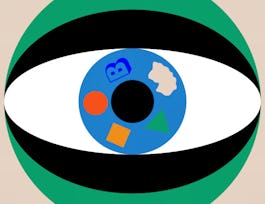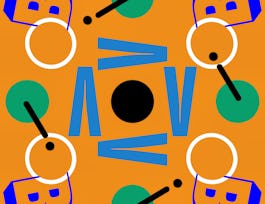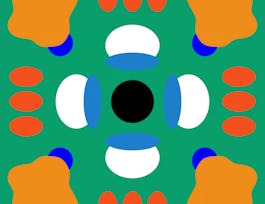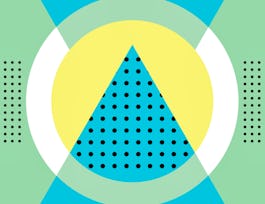Graphic Design is all around us! Words and pictures—the building blocks of graphic design—are the elements that carry the majority of the content in both the digital world and the printed world. As graphic design becomes more visible and prevalent in our lives, graphic design as a practice becomes more important in our culture.


Fundamentals of Graphic Design
This course is part of Graphic Design Specialization
Taught in English
Some content may not be translated

Instructor: Michael Worthington
765,652 already enrolled
Included with 
Course
(17,098 reviews)
98%
What you'll learn
Implement the fundamentals of color: visual, rhythm, and pattern in design
Use scale, weight, direction, texture, and space in a composition
Typeset text and experiment with letter forms
Create your own series of images using different image making techniques
Skills you'll gain
Details to know

Add to your LinkedIn profile
2 quizzes
Course
(17,098 reviews)
98%
See how employees at top companies are mastering in-demand skills

Build your subject-matter expertise
- Learn new concepts from industry experts
- Gain a foundational understanding of a subject or tool
- Develop job-relevant skills with hands-on projects
- Earn a shareable career certificate


Earn a career certificate
Add this credential to your LinkedIn profile, resume, or CV
Share it on social media and in your performance review

There are 6 modules in this course
Welcome! In this first module I will summarize the assignments and expectations of this course.
What's included
4 videos8 readings1 discussion prompt
This week we are going to look at how images function in terms of conveying denotative and connotative messages, I'll show you a range of analog and digital imagemaking techniques and discuss how they work. In the first peer review assignment you'll create your own series of images, experimenting with formal techniques. Later, you'll have the opportunity to rework those images to enhance their ability to communicate an idea through connotation in an optional assignment: give it a try, it'll help you develop your communication skills as well as your formal skills!
What's included
13 videos2 peer reviews
This week we are going to look at typographic terminology and the basic rules for creating typography. I'll show you a range of tips and techniques for working with type, in both a functional and expressive manner, and you'll find out about the process involved in making and controlling typography. This week you'll complete a quiz to make sure you understand the language of typography–this is required. I also highly recommend you complete the two optional peer review assignments. In the first assignment you'll create your own typographic monogram, and you'll use that as a central element in designing a typographic business card in the second assignment. Give them a try, they are the place where you can demonstrate and apply your formal skills, and the place where you get to play with type!
What's included
12 videos1 quiz2 peer reviews
This week we are going to look at how designers work with shape and color as their fundamental building blocks. You'll learn about visual contrast, color, rhythm and pattern in design. I'll be showing you the process involved in making an abstract design from shapes, and how to use that element to create a repeating pattern design. You'll be completing a quiz (required!) to make sure you understand how visual contrast and color work, and I also highly recommend you complete the two optional peer review assignments. In the first assignment you'll create your own simple and complex design motifs, and you'll use them as the central elements in designing a repeating pattern in the second assignment. The assignments are optional, but they are the place where you get to demonstrate and apply your formal skills, so well worth taking the extra time to complete!
What's included
10 videos1 quiz2 peer reviews
This week we are going to look at how designers work with visual contrasts, cropping, hierarchy and direction in single images and complex compositions. You'll find out how to control and use scale, weight, direction, texture, and space in a composition, and how to compose work that ranges from the complex to the minimal. In the first peer review assignment you'll create your own abstract compositions that demonstrate your knowledge and control of visual contrast. In the final optional assignment, you can use all your skills from the entire course to create experimental compositions in the form of a poster for a mythical band. This last project is optional, but I strongly suggest you try it out, it'll let you grow and apply your design knowledge and really enjoy and express yourself in your design work!
What's included
12 videos1 reading3 peer reviews
In this section we've provided some useful resources for students wishing to further their studies in graphic design. The information was authored by Calvin Rye, MFA alumnus of the Graphic Design program at CalArts in consultation with CalArts' Graphic Design faculty and our Office of Admissions. In addition to some advice about selecting the right program of study, we've also included some tips for creating and presenting a strong, organized portfolio and writing your artist statement. These are essential components of any application to a graphic design program, as well as a freelance graphic designer's toolkit. Regardless if you are applying to schools or looking for work in the field, we hope you find these tips and resources useful to your goals.
What's included
4 readings
Instructor

Offered by
Recommended if you're interested in Music and Art

California Institute of the Arts

California Institute of the Arts

California Institute of the Arts

California Institute of the Arts
Why people choose Coursera for their career




Learner reviews
Showing 3 of 17098
17,098 reviews
- 5 stars
82.05%
- 4 stars
14.54%
- 3 stars
2.16%
- 2 stars
0.46%
- 1 star
0.77%

Open new doors with Coursera Plus
Unlimited access to 7,000+ world-class courses, hands-on projects, and job-ready certificate programs - all included in your subscription
Advance your career with an online degree
Earn a degree from world-class universities - 100% online
Join over 3,400 global companies that choose Coursera for Business
Upskill your employees to excel in the digital economy
Frequently asked questions
Access to lectures and assignments depends on your type of enrollment. If you take a course in audit mode, you will be able to see most course materials for free. To access graded assignments and to earn a Certificate, you will need to purchase the Certificate experience, during or after your audit. If you don't see the audit option:
The course may not offer an audit option. You can try a Free Trial instead, or apply for Financial Aid.
The course may offer 'Full Course, No Certificate' instead. This option lets you see all course materials, submit required assessments, and get a final grade. This also means that you will not be able to purchase a Certificate experience.
When you enroll in the course, you get access to all of the courses in the Specialization, and you earn a certificate when you complete the work. Your electronic Certificate will be added to your Accomplishments page - from there, you can print your Certificate or add it to your LinkedIn profile. If you only want to read and view the course content, you can audit the course for free.
If you subscribed, you get a 7-day free trial during which you can cancel at no penalty. After that, we don’t give refunds, but you can cancel your subscription at any time. See our full refund policy.

